小学英语试讲教案
小学英语面试试讲教案模板词汇课
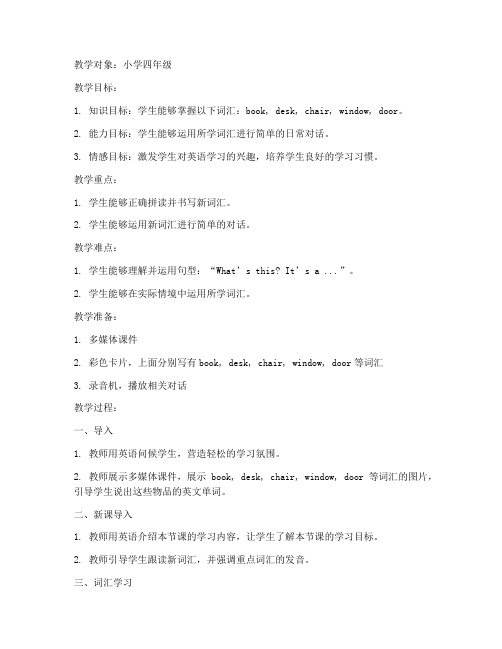
教学对象:小学四年级教学目标:1. 知识目标:学生能够掌握以下词汇:book, desk, chair, window, door。
2. 能力目标:学生能够运用所学词汇进行简单的日常对话。
3. 情感目标:激发学生对英语学习的兴趣,培养学生良好的学习习惯。
教学重点:1. 学生能够正确拼读并书写新词汇。
2. 学生能够运用新词汇进行简单的对话。
教学难点:1. 学生能够理解并运用句型:“What’s this? It’s a ...”。
2. 学生能够在实际情境中运用所学词汇。
教学准备:1. 多媒体课件2. 彩色卡片,上面分别写有book, desk, chair, window, door等词汇3. 录音机,播放相关对话教学过程:一、导入1. 教师用英语问候学生,营造轻松的学习氛围。
2. 教师展示多媒体课件,展示book, desk, chair, window, door等词汇的图片,引导学生说出这些物品的英文单词。
二、新课导入1. 教师用英语介绍本节课的学习内容,让学生了解本节课的学习目标。
2. 教师引导学生跟读新词汇,并强调重点词汇的发音。
三、词汇学习1. 教师展示彩色卡片,让学生跟读卡片上的词汇,并引导学生说出这些物品的英文单词。
2. 教师用“Show me ...”句型引导学生展示物品,并让学生用新词汇描述物品。
四、句子练习1. 教师出示句子:“What’s this? It’s a ...”,引导学生进行对话练习。
2. 教师将学生分成小组,让学生用新词汇进行对话练习。
五、巩固练习1. 教师播放相关对话录音,让学生跟读录音,巩固所学词汇和句型。
2. 教师组织学生进行角色扮演,让学生在实际情境中运用所学词汇。
六、总结1. 教师用英语总结本节课的学习内容,强调重点词汇和句型。
2. 教师鼓励学生在日常生活中运用所学词汇,养成良好的学习习惯。
教学反思:本节课通过图片、实物、游戏等多种教学手段,让学生在轻松愉快的氛围中学习新词汇。
小学英语面试试讲教案
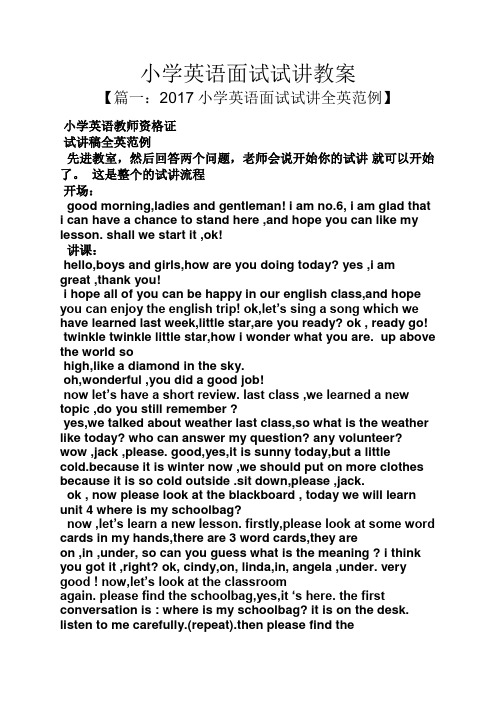
小学英语面试试讲教案【篇一:2017小学英语面试试讲全英范例】小学英语教师资格证试讲稿全英范例先进教室,然后回答两个问题,老师会说开始你的试讲就可以开始了。
这是整个的试讲流程开场:good morning,ladies and gentleman! i am no.6, i am glad that i can have a chance to stand here ,and hope you can like my lesson. shall we start it ,ok!讲课:hello,boys and girls,how are you doing today? yes ,i amgreat ,thank you!i hope all of you can be happy in our english class,and hope you can enjoy the english trip! ok,let’s sing a song which we have learned last week,little star,are you ready? ok , ready go! twinkle twinkle little star,how i wonder what you are. up above the world sohigh,like a diamond in the sky.oh,wonderful ,you did a good job!now let’s have a short review. last class ,we learned a new topic ,do you still remember ?yes,we talked about weather last class,so what is the weather like today? who can answer my question? any volunteer?wow ,jack ,please. good,yes,it is sunny today,but a littlecold.because it is winter now ,we should put on more clothes because it is so cold outside .sit down,please ,jack.ok , now please look at the blackboard , today we will learn unit 4 where is my schoolbag?now ,let’s learn a new lesson. firstly,please look at some word cards in my hands,there are 3 word cards,they areon ,in ,under, so can you guess what is the meaning ? i think you got it ,right? ok, cindy,on, linda,in, angela ,under. very good ! now,let’s look at the classroomagain. please find the schoolbag,yes,it ‘s here. the first conversation is : where is my schoolbag? it is on the desk. listen to me carefully.(repeat).then please find thekeys ,yes,they are over there. the second conversationis :where are my keys? they are under the chair. here,please pay attention to the different usage of is and are. we have talked about them many times before,i believe that you know them very well,right ?great,give me five,give me five,sit down please.now let’s listen to the tape and fill in the blank with on in or under. listen to the tape carefully ,when you finish,please hands up. ok ,stop here. all of you did a good job. i think it is very easy for you,isn’t it? because you are very clever!how time flies,it is time to say goodbye. today’s homework is make some sentences with on,in ,under ,and if you can,please teach your parents or your friends about the usage ofon,in,under.ok,that is all for today,good bye,see you next time!篇二:讲课:hi ,my dear children!(good afternoon,boys and girls!hello,everyone!) it is nice to meet you again in the beautiful sunshine day. now ,let’s began our class! let us sing the song we have learnt before.( 歌曲名字)wa~~ it is very beautiful. now we have some new friends here. who are they?ok,have a look. open your books, and turn to page 100, look, who are they? what’s the matter with them?教师出示一支体温表,说:this is a thermometer. if i have a fever, it will tell me. let’s see mike. mike doesn’t feel well. he has a fever.指着let’s learn的图片的mike,教学“have a fever。
资格证小学英语面试试讲讲义5篇
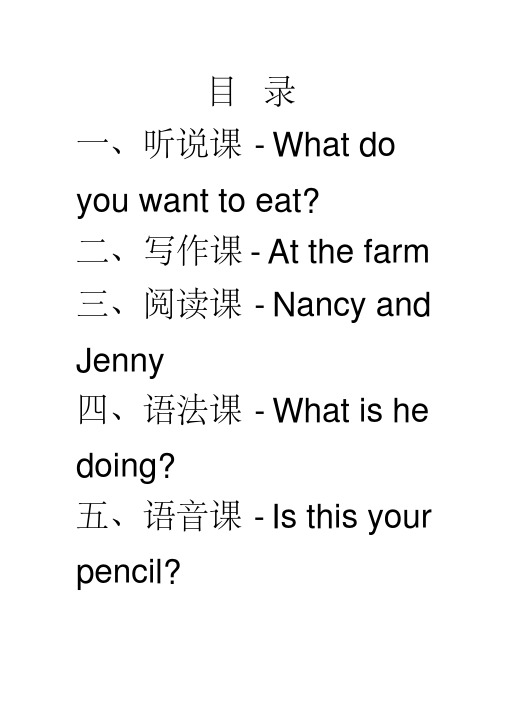
目录一、听说课-What do you want to eat?二、写作课-At the farm三、阅读课-Nancy and Jenny四、语法课-What is he doing?五、语音课-Is this your pencil?一、听说课-What do youwant to eat?1.题目:What do you want to eat?2.内容:food: ice cream, milk, cake, hamburger, pizza, hot dogA:What do you want to eat?B:I want ice cream, of course.3.基本要求:(1)全英授课(2)培养学生的口语能力,体现学生的互动性教案What do you want to eat?Teaching PlanI Teaching AimsKnowledge aims1. Students can understand the meaning of the new words, such as i ce cream, cake, hamburger and so on.2. Students can use the sentence pattern to express the food they like to eat.Ability aimThrough different activities, students can improve their listening and speaking ability.Emotional aimStudents will be confident to communicate with others in English and can cooperate with others in groupwork.II Teaching Key &Difficult PointsKey point: students can master the meaning of new words as well as sentence patterns. Difficult point: students can express the topic about food in their daily life.IIITeaching procedures:Step 1: Warming upSing a chant namedtomato with students together, the content is as follow:Tomato tomato wash washwash;Tomato tomato cut cutcut;Tomato tomato cook cookcook;Tomato tomato eat eateat;Step 2: Presentation1.Show some pictures about food, then present the new words: ice cream, milk, cake, hamburger, pizza,hot dog;2. Teacher read the words one time and students read them three times;3. Play a word game named show and say, students are divided into two groups, when teacher showstudents one picture, they should say according word, the faster group will be awarded withmore stars.Step 3: Practice1. Listen to the tape and then answer questionsabout what does B and A want to eat;2. Play a game “Hot potato” to ask Ss what do they want to eat.Step 4: ProductionStudents are required to do a pair work, one actas a waiter, and the other act as customer, thenmake anew conversation with the topic about food,and then perform it in front of the class.Step 5: Summary & HomeworkAsk students to say what they have got one byone.Students share what they like to eat to theirfamily members.IVBlackboard design二、写作课-At the farm1. 题目:At the farm2.内容:3.基本要求:(1)讲解写作(2)设计相应的教学活动(3)全英文授课教案At the farmTeaching PlanI Teaching AimsKnowledge aimStudents can read and write some words related to vegetables and animals correctly.Ability aimStudents can make connection between English words and real objects and will develop their writingability.Emotional aimStudents can find the beauty in English and foster a good habit of writing English.II Teaching Key &Difficult PointsKey point: Students can read and write some words related to vegetables and animals correctly.Difficult point: Students can make connection between English words and real objects and will developtheir writing ability.IIITeaching procedures:Step 1: Warming upGreet students. Ask them what did they so during weekends. Sing the song “old MacDonald’s farm”, thenlead in this lesson “At the farm” Step 2: Presentation&Practice1. Set up a situation that is on Mr. MacDonaldfarm, draw some pictures on the blackboardand then askstudents what they are to present differentwords related to vegetables and animals in thisclass.2. Show the picture of the farm and studentsfind out the animals and vegetables that theysee.Then let students look around the classroom.Say some sentences with the structure “the eare…”“thosare...” Step 3: Production1. Students write down their description byusing the sentence: These are.../Thoseare…about the thingsthey can see in the classroom.2. Students share their answers in the class, and teacher checks their writing and correctmistakes.3. Teacher write a right sentence on the blackboard and tell students the rule to write English sentences.Step 4: Summary & HomeworkAsk students what they have learnt in this class. Homework: share their writing with theirparents and i n troduce Mr. MacDonald’s farm to them.IVBlackboard design三、阅读课-Nancy andJenny1.题目:Nancy and Jenny2.内容:Nancy and Jenny are twin sisters. They looklike each other. Jenny’s hair is longer than Nancy’s hair.Nancy is taller than Jenny. They like running.But Nancy runs faster than Jenny. They alsolike singing.Jenny sings better Nancy. Nancy is quieter than Jenny. Jenny is smarter than Nancy. Their bagsare black.Nancy’s bag is bigger than Jenny’s bag.3.基本要求:(1)让学生读懂并理解这篇课文(2)讲解阅读技巧教案Nancy and JennyTeaching PlanI Teaching AimsKnowledge aimsStudents can understand this short passage and master some expressions about comparative degree.Ability aimsStudents will improve their reading efficiency and reading ability.Emotional aimStudents are willing to read a lot of English reading materials in their daily life.II Teaching Key &Difficult PointsKey point: Students can understand this short passage and master some expressions about comparativedegree.Difficult point: foster good habit of reading English materials in their daily life.IIITeaching procedures:Step 1: Warming upShow two pictures of Jenny and Nancy, ask students what do they find then share their answer with eachother.Step 2: PresentationRead the short passage for the first time and they need to read it as fast as the can, ask them what is themain idea of this passage and students share answers.Students read the passage for the second time and ask them to find what are the different characteristicsmentioned in the passage? Then find the exact answers. eg. Whose hair is longer?Step 3: PracticeSs do a role play. They can play Nancy or Jenny and do a self introduction.Step 4: ProductionDraw a picture of best friend and describe she/ he in Ss’ own words. Invite some students to be the story teller to introduce his or her friends.Step 5: Summary & HomeworkStudents look at the blackboard and summarize this class, and the homework is that students introduceJenny and Nancy to their friends or parents. IVBlackboard design四、语法课-What is hedoing?1.题目:What is he doing?2.内容:A: What is he doing?B: He is writing a letter.He is kicking a ball.He is flying a kite.He is watering the flowers.He is cycling.3.基本要求:(1)全英授课(2)重点讲解现在进行时(3)配合教学内容适当板书教案What is he doing?Teaching PlanI Teaching AimsKnowledge aimStudents can know the meaning and structureof simple present progressive tense.Ability aims1.Students can use the simple progressive tense to describe what the third person is doing.2.Students can improve their speaking ability. Emotional aimsStudents can improve the confidence ofspeaking English and cultivate their interest in English learning.II Teaching Key &Difficult PointsKey point: the meaning and structure ofsimple present progressive tense.Difficult point:how to improve theconfidence of speaking English and cultivatetheir interest in Englishlearning.IIITeaching procedures:Step 1: Warming-up1. Greet students2. Enjoy an English song Happy New YearStep 2: Presentation & Practice1. Guessing game. Ask students to guess the phrases of pictures about Tom’s daily life.2. Ask students to find the similarities about the verbs and explain the rule of changing intoV–ing form.Some add -ing after the root form of verbs and verbs ended with silently -e should omit the letter -e and add-ing after it.3. Give them some verbs and let them change into V-ing, dance, make, give, clean,play, sing.Step 3: ProductionAsk them to take out the family photos and introduce their family members with present progressive tense.Step 4: Summary & HomeworkAsk students to review what they have learnt. Homework: Practice the sentence pattern with their parents.IVBlackboard design五、语音课-Is this yourpencil?1.题目:Is this your pencil?2.内容:red robot ruler rubber(1) A red robot have a ruler and a rubber(2) rhyme time3.基本要求:(1)要求设计成语音课(2)全英文试讲(3)有适当板书教案Is this your pencil?Teaching PlanI Teaching AimsKnowledge aims1. Students can master the pronunciation of r- and the letter group -er.2. Students can know the meaning of the four words.Ability aims1.Students can pronounce r- and -er correctly and clearly.2.Students can read some English tongue twister.Emotional aimStudents can improve the confidence of English learning and foster the interest in speaking English.II Teaching Key &Difficult PointsKey point: the pronunciation of r- and theletter group -er.Difficult point: how to read English tongue twister fluently and correctly.IIITeaching procedures:Step 1: Warming-upGreet studentsTry to read some tongue twisters.A. My name’s Jake, I make a cake. I put it on a plate, And eat it by the lake.B. She sells seashells by the seashoresStep 2: Presentation & Practice1. Draw a stick figure of the robot with a rulerand a rubber in his hand, painting the robot witha redchalk, and learn the four new words together, then read after the teacher for three times.2. Emphasize the pronunciation of r- and -er. ([r]curl the tongue tip close to the upper gum, have a roundmouth shape, vocal cord vibrate. [?r] curl the tongue)3. Recall more words with r- or -erStep 3: ProductionGroup work. Organizing the words into tongue twisters with -er or -r. (A red robot has a ruler and a rubber.Red rose is raised in a reading room. Whether the weather be fine or whether the weather be not. Whether theweather be cold or whether the weather be hot. We’ll weather the weather whether we like it or not.)Step 4: Summary & HomeworkAsk students read the words and tongue twisters as a summary.Homework: Collect more tongue twister after class and share with others next class.IVBlackboard design。
小学英语面试教案
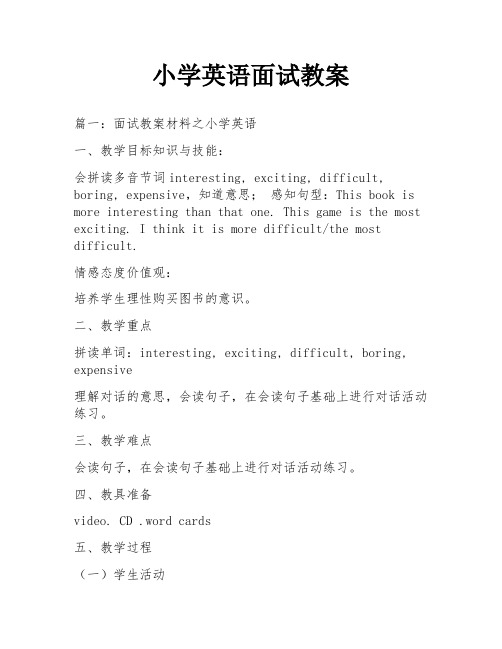
小学英语面试教案篇一:面试教案材料之小学英语一、教学目标知识与技能:会拼读多音节词interesting, exciting, difficult, boring, expensive,知道意思;感知句型:This book is more interesting than that one. This game is the most exciting. I think it is more difficult/the most difficult.情感态度价值观:培养学生理性购买图书的意识。
二、教学重点拼读单词:interesting, exciting, difficult, boring, expensive理解对话的意思,会读句子,在会读句子基础上进行对话活动练习。
三、教学难点会读句子,在会读句子基础上进行对话活动练习。
四、教具准备video. CD .word cards五、教学过程(一)学生活动Greeting to teacher.Nice to meet you ,too !Answer teacher’s questionsIt’s a book.Bookstore/bookshopAnswer questionsYes I do. /No I don’t.Translate the dialogue in groups with teacher’s questions.Know about “e”.Watch the videoThey are Ken Ann and Mocky .They went to the bookstore.An e-book.Monkey King.《美猴王》Watch the dialogue again and draw a line .Answer questions about the dialogue.Listen to the dialogue ,talk about the meaning of the dialogue together.Read the words follow the teacher .Listen and repeat the dialogues.read follow teacher.Listen & guess the right picture.Boys for KenGirls for AnnTeacher for Mockey.Act the story in groups.(二)教师活动一: Warming upGreetingNice to meet you!二: Language preparation1 Show a English books & askWhat’s this? It’s a ________.We can buy it in _________.Do you like English book/music book/story book/ic book ?2 For the titleToday we will learn “Buying e-book”.(write thetitle )Do you know e-book?Explain “e”. e-mail?三: learn the story1 Watch and answer.(Show the video)Ask students to watch the video with the question :Who are they?Where did they go last Sunday?What book did they buy at last?What’s the name of the e-book?Do you know the Chinese meaning?Explain.2 Show the video.What books did they found before e- book? Draw a line under the book. 3 Listen & translate.play the video one by one and talk about the meaning(write the new words or put the word cards on blackboard.) 4 Read & spellRead the words .四: Practice1 Watch & repeatPlay the video again.Play it one by one2 ReadAsk students to read follow teacher.3 GameListen to the dialogue and guess the right picture . 4 Act the story in different roles.Read mockey’s speaking.5 Act the story in groups.五:Homework1 Repeat the story five times2 Read the dialogues & try to know the text.(六)板书设计Unit 10 Buying e-booksLesson 1interesting exciting difficultboring expensiveThis book is interesting.This book is more interesting . (than that one.)This book is the most interesting.篇二:小学英语面试教案三年级上册Unit4WeloveanimalsALet`slearn教学设计一、教学内容:《PEP 小学英语》(供三年级使用)三年级上册 Unit 4 We love animals. Part A Let's learn.二、教学设计理念:英语课程标准明确指出,根据小学生的生理和心理特点以及发展需要.小学阶段英语课程的目的是:激发学生学习英语的兴趣,培养他们英语学习的积极态度,使他们建立初步的学习英语的自信心,培养他们一定的语感和良好的语音、语调基础,使他们形成初步用英语进行简单日常交流的能力,为进一步学习打下基础。
小学英语试讲10分钟模板
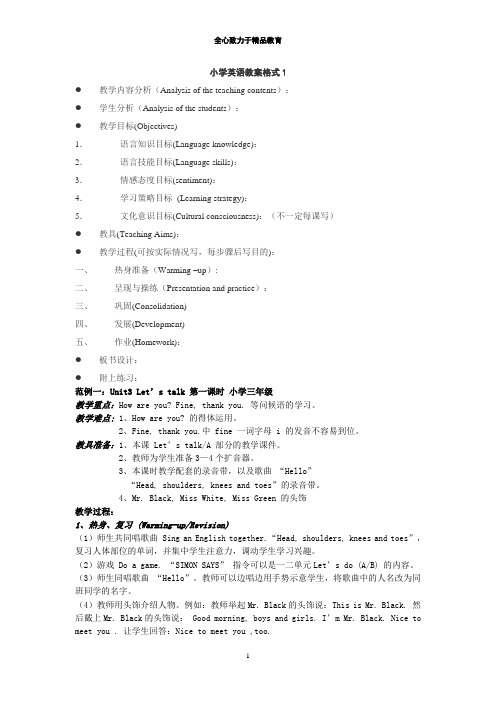
小学英语教案格式1●教学内容分析(Analysis of the teaching contents):●学生分析(Analysis of the students):●教学目标(Objectives)1.语言知识目标(Language knowledge):2.语言技能目标(Language skills):3.情感态度目标(sentiment):4.学习策略目标(Learning strategy):5.文化意识目标(Cultural consciousness):(不一定每课写)●教具(Teaching Aims):●教学过程(可按实际情况写,每步骤后写目的):一、热身准备(Warming –up):二、呈现与操练(Presentation and practice):三、巩固(Consolidation)四、发展(Development)五、作业(Homework):●板书设计:●附上练习:范例一:Unit3 Let’s talk 第一课时小学三年级教学重点:How are you? Fine, thank you. 等问候语的学习。
教学难点: 1、How are you? 的得体运用。
2、Fine, thank you.中 fine 一词字母 i 的发音不容易到位。
教具准备:1、本课Let’s tal k/A 部分的教学课件。
2、教师为学生准备3—4个扩音器。
3、本课时教学配套的录音带,以及歌曲“Hello”“Head, shoulders, knees and toes”的录音带。
4、Mr. Black, Miss White, Miss Green 的头饰教学过程:1、热身、复习 (Warming-up/Revision)(1)师生共同唱歌曲 Sing an English together.“Head, shoulders, knees and toes”,复习人体部位的单词,并集中学生注意力,调动学生学习兴趣。
少儿英语试讲教案颜色

少儿英语试讲教案-颜色一、教学背景•年龄:3-4岁•学习内容:颜色•学习目标:通过教学活动,使学生学会一些基本的颜色词汇,并能够正确运用这些颜色词汇进行简单的交流。
二、教学准备•少儿英语教材•彩色图片或实物:红色、黄色、蓝色、绿色、橙色、紫色•单词卡片:red, yellow, blue, green, orange, purple三、教学过程1. 导入活动•引导学生进行问候与自我介绍,为今天的教学活动做好准备。
2. 呈现和学习新词汇•准备彩色图片或实物,并逐个展示给学生。
•朗读每个颜色单词,让学生重复跟读。
•将单词卡片放在黑板上,引导学生边看边说。
3. 执行游戏活动•游戏1:猜颜色–将颜色卡片随机打乱,每次从中抽取一张,让学生猜出是什么颜色,并说出该颜色的单词。
–学生回答正确后,给予鼓励,并将卡片贴在黑板上的相应颜色上。
•游戏2:找颜色–指定一个学生站在黑板前,教师给他一个颜色名称,其他学生则在课堂中找到相应颜色的物品(可以是彩色笔、颜色糖果等)给该学生。
•游戏3:模仿游戏–教师以自己的方式模仿某种颜色,学生观察并猜出是哪种颜色。
–学生回答正确后,鼓励他们模仿这种颜色的动作。
4. 色彩拓展活动•制作彩虹画–教师准备五颜六色的纸张,指导学生将纸张剪成彩虹的形状,并将不同颜色的纸条粘贴在彩虹上。
–引导学生说出每个纸条的颜色,并加强颜色词汇的记忆。
•调色板游戏–展示一张调色板图片,上面有不同的颜色块。
–告诉学生颜色的英文名称,让他们模仿教师将相应颜色的纸条粘贴到调色板上。
–引导学生彼此交流:“Give me the blue color”, “Stick the yellow paper on the green color”等等。
5. 教学总结•教师复习所学颜色的单词,并进行总结。
•学生回答问题并展示他们制作的彩虹画。
四、教学评估•在整个教学过程中,教师进行了语言能力和颜色词汇的评估,如课堂回答问题、游戏参与等。
小学英语松鼠试讲教案模板

教学目标:1. 让学生学会用英语描述松鼠的特点。
2. 培养学生的口语表达能力和听力理解能力。
3. 培养学生对动物的兴趣,提高环保意识。
教学重点:1. 松鼠的英语单词和短语:squirrel,tail,acorn,tree,forest。
2. 松鼠的英语句型:What does a squirrel look like? It has a long tail and sharp teeth. It eats acorns. It lives in the forest.教学难点:1. 学生对松鼠英语单词和短语的掌握。
2. 学生对松鼠英语句型的运用。
教学过程:一、导入1. 教师展示松鼠的图片,引导学生说出图片中的动物是什么。
2. 学生回答:Squirrel.3. 教师简要介绍松鼠的特点,如:长尾巴、尖牙齿、喜欢吃橡子、生活在森林里等。
二、单词教学1. 教师带领学生一起学习松鼠的英语单词:squirrel,tail,acorn,tree,forest。
2. 学生跟读,教师纠正发音。
3. 教师出示单词卡片,让学生上台拼读。
三、句型教学1. 教师展示松鼠的图片,引导学生用英语描述图片中的松鼠。
2. 学生回答:What does a squirrel look like? It has a long tail andsharp teeth.3. 教师引导学生用句型:It eats acorns. It lives in the forest. 来描述松鼠的饮食习惯和居住环境。
4. 学生跟读,教师纠正发音。
四、游戏环节1. 教师将学生分成若干小组,每组派一名代表上台。
2. 教师出示松鼠的英语单词卡片,小组代表需用英语描述图片中的松鼠。
3. 教师判断学生描述是否正确,正确的小组得分。
4. 最后,得分最高的小组获胜。
五、总结1. 教师引导学生回顾本节课所学的英语单词和句型。
2. 学生跟读,教师纠正发音。
3. 教师鼓励学生课后多观察动物,提高环保意识。
小学教资英语优秀试讲教案《Hobbies》
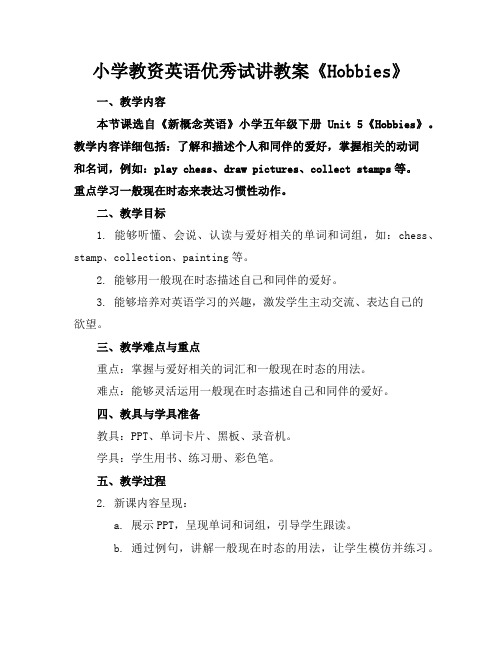
小学教资英语优秀试讲教案《Hobbies》一、教学内容本节课选自《新概念英语》小学五年级下册Unit 5《Hobbies》。
教学内容详细包括:了解和描述个人和同伴的爱好,掌握相关的动词和名词,例如:play chess、draw pictures、collect stamps等。
重点学习一般现在时态来表达习惯性动作。
二、教学目标1. 能够听懂、会说、认读与爱好相关的单词和词组,如:chess、stamp、collection、painting等。
2. 能够用一般现在时态描述自己和同伴的爱好。
3. 能够培养对英语学习的兴趣,激发学生主动交流、表达自己的欲望。
三、教学难点与重点重点:掌握与爱好相关的词汇和一般现在时态的用法。
难点:能够灵活运用一般现在时态描述自己和同伴的爱好。
四、教具与学具准备教具:PPT、单词卡片、黑板、录音机。
学具:学生用书、练习册、彩色笔。
五、教学过程2. 新课内容呈现:a. 展示PPT,呈现单词和词组,引导学生跟读。
b. 通过例句,讲解一般现在时态的用法,让学生模仿并练习。
3. 例题讲解:讲解如何用一般现在时态描述爱好,并以教师为例进行示范。
4. 随堂练习:学生两人一组,互相用一般现在时态描述对方的爱好。
5. 小组活动:每组选择一种共同的爱好,用一般现在时态制作海报,并进行展示。
六、板书设计1. 爱好相关词汇:chess、stamp、collection、painting等。
2. 一般现在时态的句子结构:主语 + 动词原形 + 其他。
3. 例句:I like playing chess. He collects stamps.七、作业设计1. 作业题目:用一般现在时态写一段话,描述你的爱好和家人的爱好。
答案示例:My hob is drawing pictures. My father likes playing chess, and my mother enjoys cooking.八、课后反思及拓展延伸1. 反思:关注学生在课堂上的参与度,对学生的发音、语法进行纠正和指导。
小学英语三年级试讲教案十分钟

小学英语三年级试讲教案十分钟教学过程:Step 1.Warm up and revi-sion1.Let’S chant(见到第一单元)师生随着音乐的节奏,边说唱边做动作。
‘2.FreeTalk利用多媒体展示学生感兴趣的“超级女声”李宇春和动画人物孙悟空,引导学生用“Goodmorning I/Hell0 1/This is…/Niceto meet you”等句型把自己的朋友介绍给他们认识,与图中人物进行口语交流。
(贴近学生生活的实际设计,让学生有话可说、有话想说,从而达到语言交际的目的,为他们尽快进入英语学习氛围做铺垫。
)Step 2.Presentation1.老师戴上米老鼠的头饰,说:Good morning!/Hi I’mMichey.Look at me.并对着自己的头了解:This is my head同样依次了解:face、ear、eye、nose、mouth2.PowerPoint制作:打开幻灯片后每页面一身体部位就可以出现相应的单词。
注mouth一词的尾音发音较难,老师适当提醒学生,注意口型。
3.拼字head、face、ear、eye、nose、mouth的单词卡片和图片。
4.老师借助肢体语言,比如,指着自己的头说:my head指着学生的头说:your head再通过my face、your face;my pen、your pen等让学生领会其意思。
然后指导学生互相叙述对方说道:This is your head.This is myhead・・・・・・5.老师通过动作教“Touch”。
比如,摸自己的头说:Touch my head.Step3:Practice1.让学生听录音,跟读Let’S learn部分的词汇并要求学生指着自己头部相应的部位,力求做到“眼到、手到、口到、心到”。
2.Listen and Do.老师说词,学生快速搞适当的动作,然后打听学生替代老师搞。
如touchyourface。
小学英语面试试讲教案模板
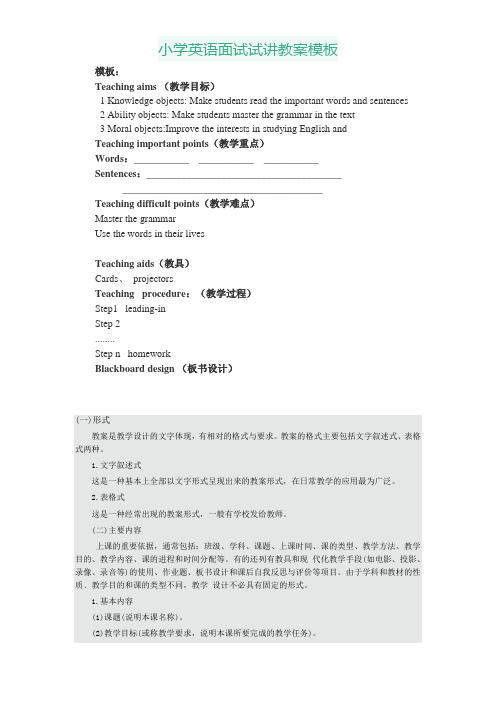
模板:Teaching aims (教学目标)1 Knowledge objects: Make students read the important words and sentences2 Ability objects: Make students master the grammar in the text________3 Moral objects:Improve the interests in studying English and_________Teaching important points(教学重点)Words:___________ ___________ ___________Sentences:_______________________________________________________________________________Teaching difficult points(教学难点)Master the grammarUse the words in their lives____________________Teaching aids(教具)Cards、projectors _________ __________ ________Teaching procedure:(教学过程)Step1 leading-inStep 2 __________........Step n homeworkBlackboard design (板书设计)(一)形式教案是教学设计的文字体现,有相对的格式与要求。
教案的格式主要包括文字叙述式、表格式两种。
1.文字叙述式这是一种基本上全部以文字形式呈现出来的教案形式,在日常教学的应用最为广泛。
2.表格式这是一种经常出现的教案形式,一般有学校发给教师。
(二)主要内容上课的重要依据,通常包括:班级、学科、课题、上课时间、课的类型、教学方法、教学目的、教学内容、课的进程和时间分配等。
小学英语教师资格证面试教案模板(共8)
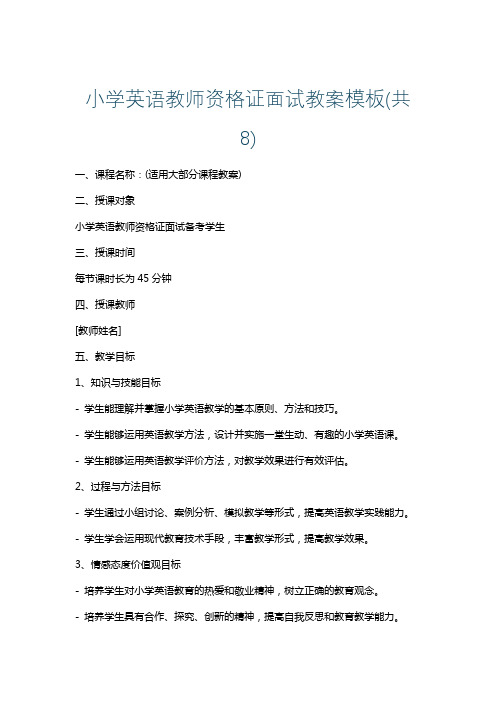
小学英语教师资格证面试教案模板(共8)一、课程名称:(适用大部分课程教案)二、授课对象小学英语教师资格证面试备考学生三、授课时间每节课时长为45分钟四、授课教师[教师姓名]五、教学目标1、知识与技能目标- 学生能理解并掌握小学英语教学的基本原则、方法和技巧。
- 学生能够运用英语教学方法,设计并实施一堂生动、有趣的小学英语课。
- 学生能够运用英语教学评价方法,对教学效果进行有效评估。
2、过程与方法目标- 学生通过小组讨论、案例分析、模拟教学等形式,提高英语教学实践能力。
- 学生学会运用现代教育技术手段,丰富教学形式,提高教学效果。
3、情感态度价值观目标- 培养学生对小学英语教育的热爱和敬业精神,树立正确的教育观念。
- 培养学生具有合作、探究、创新的精神,提高自我反思和教育教学能力。
六、教学重占和难点1、教学重点- 小学英语教学的基本原则、方法和技巧。
- 英语教学设计、实施与评价。
- 现代教育技术手段在英语教学中的应用。
2、教学难点- 如何针对小学生的年龄特点,设计富有吸引力、互动性强的英语教学活动。
- 如何在有限的课时内,实现教学目标,提高学生的英语实际运用能力。
- 如何运用英语教学评价方法,对教学效果进行客观、全面的评估。
七、教学过程1、导入新课(5分钟)- 教师以生动的故事、歌曲或游戏等方式引起学生的兴趣,为新课的学习营造轻松愉快的氛围。
- 通过提问或展示与新课相关的图片、视频等资源,激发学生的好奇心和求知欲。
- 确保导入环节简洁明了,与新知识紧密相关,为学生进入新知讲授做好铺垫。
2、新知讲授(20分钟)- 教师采用讲解、示范、互动问答等方法,系统传授小学英语教学的基本原则、方法和技巧。
- 结合具体教学案例,分析并解释如何在实际教学中应用这些原则和方法。
- 强调学生主动参与,鼓励提问和发表观点,确保学生对新知识的理解和吸收。
3、合作探究(15分钟)- 将学生分成小组,针对某一教学主题或问题进行讨论和探究。
2.小学英语教师面试:听力课《Myday》全英文教案及试讲逐字稿
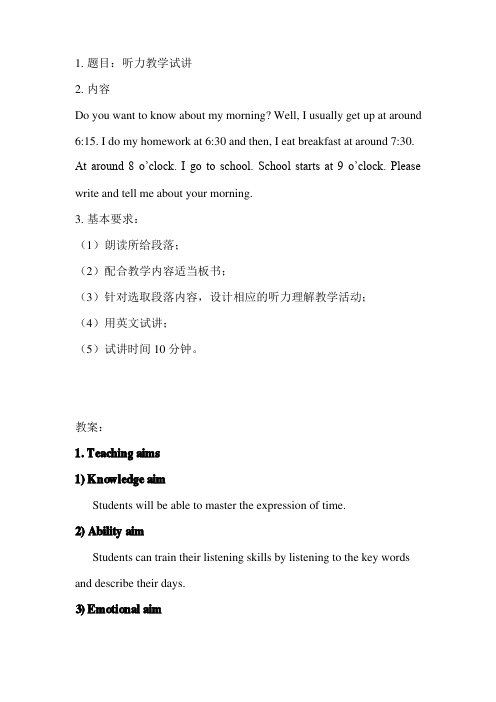
1.题目:听力教学试讲2.内容Do you want to know about my morning? Well, I usually get up at around 6:15. I do my homework at 6:30 and then, I eat breakfast at around 7:30. At around8o’clock.I go to school.School starts at9o’clock.Please write and tell me about your morning.3.基本要求:(1)朗读所给段落;(2)配合教学内容适当板书;(3)针对选取段落内容,设计相应的听力理解教学活动;(4)用英文试讲;(5)试讲时间10分钟。
教案:1. Teaching aims1) Knowledge aimStudents will be able to master the expression of time.2) Ability aimStudents can train their listening skills by listening to the key words and describe their days.3) Emotional aimStudents can realize time is life.2. Important and difficult points1) Important pointStudents will be guided to review the expression of time.2) Difficult pointStudents will improve their listening skills as well as the ability to use the expression of time to describe their days and communicate freely.3. Teaching and learning methodsSituational teaching method;communicative teaching method; task-based teaching method;group work method;cooperation study method; independent study method4. Teaching proceduresStep 1: warming up & Lead inI will play a game named“ wolf, wolf, what time is it?” to review the expression of time.Step 2: Pre-listeningFree talk:Students can guess and talk about what can you do at 6:15/7:00?Step 3: While-listening1) Students can listen to the tape and answer two questions:Q1: How many times are there in this material?Q2: What are they?2) Students can listen again and answer 3 questions:Q1: What should I do at 6:15?Q2: What should I do at 7:30?Q3: What should I do at 8:00?3) I will play the tape for the third time. Students should read after the tape.Step 4: Post-listeningStudents can make their own mind-map to describe their mornings or days.Step 5: Summary and homeworkI lead them to summarize what they have learned in this class.Homework:interview your parents‘what can you do in your morning?’.5. Blackboard designMy day6:15→6:30→7:30→ 8:00→ 9:00试讲稿:GreetingHello everyone,what’s the weather like today?Yeah it’s a sunny day. I hope everyone has a beautiful mood like the weather.1. Warming up& lead inOK,before our class,let’s play a little game named:wolf,wolf,what time is it? You can imagine that I’m a big wolf, you’re the little sheep. When I catch you, you should answer my question: what time is it? If you answer it correctly,you’re free.If not,I’ll eat you,you’re died.clear? Haha, let’s have a try. Wow, Joe, you’re the lucky dog. Please look at the picture, what time is it? Yeah, gre at, give me five, you’re so cool, it’s 7 o’clock. Read after me please, it’s 7 o’clock. It’s 7 o’clock. Great! Let’s go on. Oo, Sarah, it’s your turn. What time is it? Wonderful, 6: 15. Give me five, thank you. Go on, please. Haha, Jill. What time is it? Cool! 7:30. Give me five, thank you.2. Pre-listeningNow, guys, please look at here. There are some pictures, can you guess what they do at these time?6:15,what should you do?Yeah,get up. Emem, you can say, I get up ... yes,great, I get up at 6:15. Oh, you brush your teeth. So you can say, wow, cool, so clever, I brush my teeth at 6:15. How about 7 o’clock? Oh, go to school, eat breakfast. Yeah, we usually go to school or eat breakfast at 7:00.。
小学教资英语优秀试讲教案《Hobbies》

小学教资英语优秀试讲教案《Hobbies》一、教学内容本节课选自《小学英语》教材第五册,第十二章《Hobbies》。
详细内容主要围绕各种兴趣爱好展开,包括介绍不同的个人爱好,如何表达喜欢做某事,以及通过爱好进行简单对话。
二、教学目标1. 学生能够听懂并准确说出常见的兴趣爱好相关词汇和短语。
2. 学生能够使用一般现在时表达自己和他人的兴趣爱好。
三、教学难点与重点教学难点:一般现在时态的运用和兴趣爱好相关词汇的正确发音。
教学重点:学会表达自己的兴趣爱好,并能够进行简单对话。
四、教具与学具准备1. 教具:PPT,单词卡片,录音机,磁带。
2. 学具:学生用书,练习册,画笔,彩色纸。
五、教学过程2. 新课内容呈现(15分钟):使用PPT呈现本节课的主要词汇和句型,配合录音机播放标准发音,引导学生模仿跟读。
a. 学习新词汇:reading, drawing, playing chess,playing soccer, dancing, singing等。
b. 学习句型:What do you like to do? I like to read books. What hobbies does he/she have? He/She likes to play chess.3. 实践情景引入(10分钟):将学生分成小组,每组选择一种爱好,用所学的词汇和句型进行角色扮演,进行情景对话。
4. 例题讲解(10分钟):针对一般现在时的用法,给出例题,让学生进行句子填空练习。
5. 随堂练习(10分钟):学生完成练习册上关于爱好和一般现在时的练习题,教师进行解答和指导。
六、板书设计1. Hobbies2. 主要词汇:reading, drawing, playing chess, playing soccer, dancing, singing等。
3. 句型:What do you like to do? I like to read books. What hobbies does he/she have? He/She likes to play chess.七、作业设计1. 作业题目:请用一般现在时描述你的三个兴趣爱好,并写出你朋友的兴趣爱好。
小学英语优秀试讲教案5篇

小学英语优秀试讲教案5篇小学英语优秀试讲教案1英语是一种语言,而非一般的知识。
脱离了一定的情境,语言就难以恰当地表述,难以发挥其表达进行交际活动的实质作用。
词汇教学是小学英语教学的一个重点,也是一个难点。
小学生笼统思维能力较差,主要以机械记忆为主。
他们对枯燥乏味的教学内容,难于集中注意力,容易发生厌倦感,以至于影响教学效果。
因此,在词汇教学中,增强词汇教学的趣味性就显得尤为重要。
我们尽可能根据教学内容、教学目标、小同学的心理特点等等,尽量采取丰富多样的教学形式,激发他们的学习兴趣,调动他们的学习积极性,以达到课堂教学的最佳效果。
一、本节课的教学内容与要求本节课是PEP Book3第五单元第一课时。
这是以“食物”为话题,主要教学“rice,noodle, fish, beef, soup, vegetable .”这6个新词,复习“Can I have some…, please? Sure. Here you are. 句型,并初步掌握What would you like for dinner ? Id like some…新句型。
并能积极的运用所学英语进行表达、交流,从而进一步激发和培养同学学习英语的兴趣,发展自主学习的能力以和综合运用英语的能力。
二、本节课优秀教案(一)、Warm-up1.Greetings.2. Lets sing:Apple song(二)、Revision1、Ask and answer:T: Good morning. Ss: Good morning.T: Whats your name? Ss: My name is ….T: How are you ? Ss: Fine, thank you.T: How old are you? Ss: I am 11.…2、Lead-inT: Look at the screen. This is my room. Whats this?Ss: Its a TV/sofa/shelf/fridge/bed…T: Do you like it?Ss: Yes, I do. / No, I dont.T: Then whats on the table?Ss: Eggs/Bread/Milk/Chicken/Juice/Hot dog/Hamburger…(用富有节奏的歌声将同学带入英语学习的乐园,调动同学的积极性,也为新的学习作好语言知识和情感态度上的准备。
小学招聘英语试讲教案模板(共7篇)
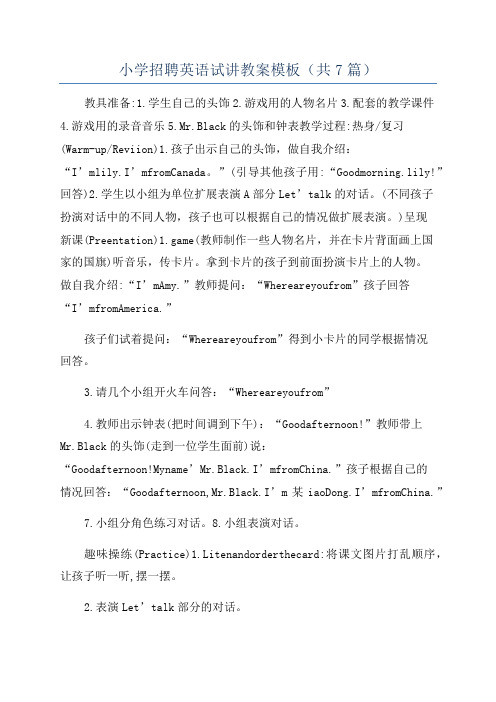
小学招聘英语试讲教案模板(共7篇)教具准备:1.学生自己的头饰2.游戏用的人物名片3.配套的教学课件4.游戏用的录音音乐5.Mr.Black的头饰和钟表教学过程:热身/复习(Warm-up/Reviion)1.孩子出示自己的头饰,做自我介绍:“I’mlily.I’mfromCanada。
”(引导其他孩子用:“Goodmorning.lily!”回答)2.学生以小组为单位扩展表演A部分Let’talk的对话。
(不同孩子扮演对话中的不同人物,孩子也可以根据自己的情况做扩展表演。
)呈现新课(Preentation)1.game(教师制作一些人物名片,并在卡片背面画上国家的国旗)听音乐,传卡片。
拿到卡片的孩子到前面扮演卡片上的人物。
做自我介绍:“I’mAmy.”教师提问:“Whereareyoufrom”孩子回答“I’mfromAmerica.”孩子们试着提问:“Whereareyoufrom”得到小卡片的同学根据情况回答。
3.请几个小组开火车问答:“Whereareyoufrom”4.教师出示钟表(把时间调到下午):“Goodafternoon!”教师带上Mr.Black的头饰(走到一位学生面前)说:“Goodafternoon!Myname’Mr.Black.I’mfromChina.”孩子根据自己的情况回答:“Goodafternoon,Mr.Black.I’m某iaoDong.I’mfromChina.”7.小组分角色练习对话。
8.小组表演对话。
趣味操练(Practice)1.Litenandorderthecard:将课文图片打乱顺序,让孩子听一听,摆一摆。
2.表演Let’talk部分的对话。
3.小组中互换头饰(国家、名字),进行对话练习。
(WhereareyoufromI’mfrom…)扩展性活动(Add-activitie)介绍好朋友,请孩子用所学的句型把自己的好朋友介绍给大家。
2024年小学教资英语优秀试讲教案《Hobbies》
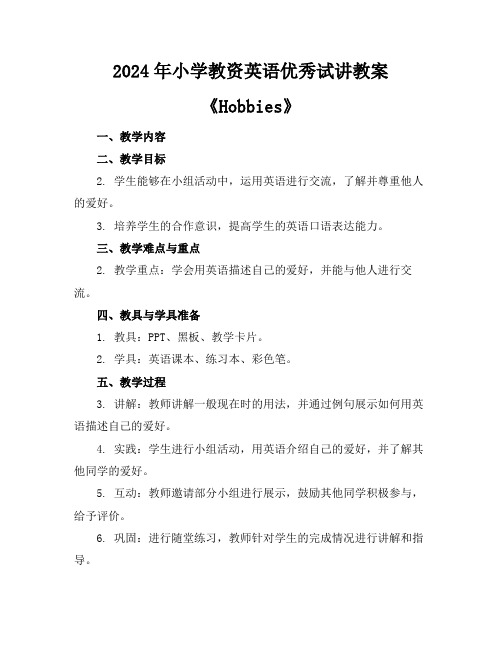
2024年小学教资英语优秀试讲教案《Hobbies》一、教学内容二、教学目标2. 学生能够在小组活动中,运用英语进行交流,了解并尊重他人的爱好。
3. 培养学生的合作意识,提高学生的英语口语表达能力。
三、教学难点与重点2. 教学重点:学会用英语描述自己的爱好,并能与他人进行交流。
四、教具与学具准备1. 教具:PPT、黑板、教学卡片。
2. 学具:英语课本、练习本、彩色笔。
五、教学过程3. 讲解:教师讲解一般现在时的用法,并通过例句展示如何用英语描述自己的爱好。
4. 实践:学生进行小组活动,用英语介绍自己的爱好,并了解其他同学的爱好。
5. 互动:教师邀请部分小组进行展示,鼓励其他同学积极参与,给予评价。
6. 巩固:进行随堂练习,教师针对学生的完成情况进行讲解和指导。
六、板书设计1. 《Hobbies》2. 主要内容:一般现在时的结构:主语 + 动词原形。
例句:I like reading books. He enjoys playing football.七、作业设计1. 作业题目:用一般现在时描述自己的爱好,并写出至少三个理由。
2. 答案示例:My hob is drawing. I like drawing because it makes me feel relaxed. Also, I can express my feelings through my drawings. What's more, drawing helps me improve my creativity.八、课后反思及拓展延伸1. 课后反思:关注学生在课堂上的参与度,了解学生对爱好词汇和一般现在时的掌握情况,针对学生存在的问题进行针对性的辅导。
重点和难点解析1. 教学内容的难点与重点2. 教学过程中的互动与实践环节3. 作业设计中的拓展延伸一、教学内容的难点与重点制作词汇卡片:正面写英文单词,背面写中文翻译,方便学生随时查阅。
小学英语优秀试讲教案
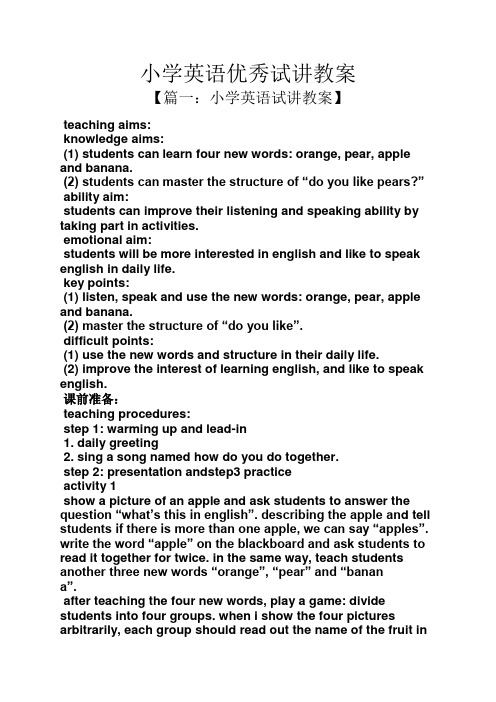
小学英语优秀试讲教案【篇一:小学英语试讲教案】teaching aims:knowledge aims:(1) students can learn four new words: orange, pear, apple and banana.(2) students can master the structure of “do you like pears?” ability aim:students can improve their listening and speaking ability by taking part in activities.emotional aim:students will be more interested in english and like to speak english in daily life.key points:(1) listen, speak and use the new words: orange, pear, apple and banana.(2) master the structure of “do you like”.difficult points:(1) use the new words and structure in their daily life.(2) improve the interest of learning english, and like to speak english.课前准备:teaching procedures:step 1: warming up and lead-in1. daily greeting2. sing a song named how do you do together.step 2: presentation andstep3 practiceactivity 1show a picture of an apple and ask students to answer the question “what’s this in english”. describing the apple an d tell students if there is more than one apple, we can say “apples”. write the word “apple” on the blackboard and ask students to read it together for twice. in the same way, teach students another three new words “orange”, “pear” and “banana”.after teaching the four new words, play a game: divide students into four groups. when i show the four pictures arbitrarily, each group should read out the name of the fruit inthe picture. the group reading all names in the least time will be the winner.activity 2i will say that i like pears very much and explain why i like pears best. tell students when iask them the question “do you like pears”, they can answer “yes, i do” if they like and “no, i don’t” if they do not like.invite some students to answer my questions “do you like apples/oranges/bananas” by using the structure of “yes, i do” or “no, i don’t”.play the tape for the first time and ask students to listen carefully. play the tape for the second time and ask students to answer the question “if the boy likes pears” after listening. play the tape for the third time and ask students to read after the tape.give students 3 minutes to make conversations with their deskmates and then invite two groups to perform.activity 3make the chant on the book.step 4: summary and homeworkask two students to talk about what we have learned in this class. make some supplements after their shares. tell students to teach their parents the chant we did just now.blackboard design:【篇二:英语试讲教案模板】模板:teaching aims (教学目标)1 knowledge objects: make students read the important words and sentences2 ability objects: make students master the grammar in the text________3 moral objects:improve the interests in studying english and_________teaching important points(教学重点)words:_________________________________sentences:_______________________________________________________________________________teaching difficult points(教学难点)master the grammaruse the words in their lives____________________teaching aids(教具)cards、 projectors _________ __________ ________teaching procedure:(教学过程)step1 leading-instep 2 __________........step n homeworkblackboard design (板书设计)(一)形式教案是教学设计的文字体现,有相对的格式与要求。
小学教资英语面试教案模板

小学教资英语面试教案模板
一、教案背景
在小学教资英语面试中,教员需准备一个完整的教案来展示自己的教学观念和教学能力。
下面是一个小学教资英语面试教案模板,供教员参考和借鉴。
二、教学目标
1.帮助学生掌握基本的英语单词和短语;
2.培养学生的英语口语表达能力;
3.激发学生学习英语的兴趣。
三、教学重点
1.重点学习关于日常生活的基本英语单词;
2.重点练习英语口语交流能力。
四、教学准备
1.课件PPT;
2.英语学习小单词卡片。
五、教学过程
### 第一部分:导入 1. 利用课件PPT展示一些常见的英语单词,如book、pen、apple等,让学生熟悉这些单词。
2. 通过图片和肢体语言引导学生理解单词的含义。
### 第二部分:学习 1. 老师逐个读出单词,学生跟读; 2. 让学生自由组合这些单词,进行简单的句子构建。
### 第三部分:练习 1. 分成小组,让学生相互问候并互相介绍; 2. 鼓励学生围绕日常生活用品进行简单的英文交流。
六、教学反馈
1.教师在课后给学生个别反馈,鼓励他们继续学习;
2.教师鼓励学生多多练习口语,提高英语表达能力。
七、教学总结
通过本节课的教学,学生基本掌握了一些基础英语单词,同时也培养起了一定的口语表达能力。
希望学生能在日常生活中多多练习英语,不断提升自己的英语水平。
以上是一份小学教资英语面试教案模板,供教员们灵活运用。
小学英语试讲国赛教案模板
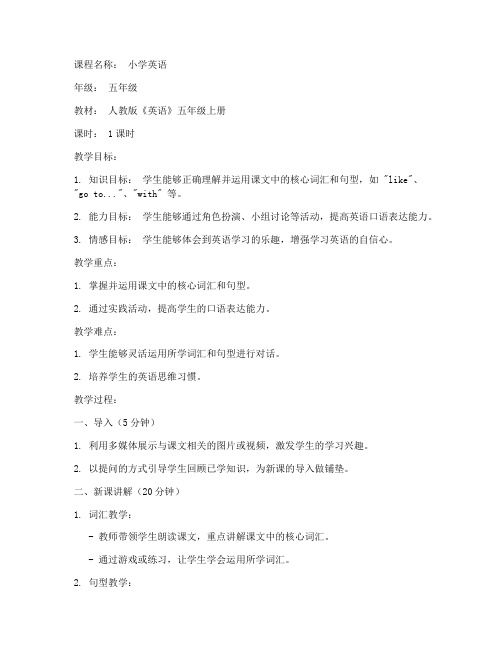
课程名称:小学英语年级:五年级教材:人教版《英语》五年级上册课时: 1课时教学目标:1. 知识目标:学生能够正确理解并运用课文中的核心词汇和句型,如 "like"、"go to..."、"with" 等。
2. 能力目标:学生能够通过角色扮演、小组讨论等活动,提高英语口语表达能力。
3. 情感目标:学生能够体会到英语学习的乐趣,增强学习英语的自信心。
教学重点:1. 掌握并运用课文中的核心词汇和句型。
2. 通过实践活动,提高学生的口语表达能力。
教学难点:1. 学生能够灵活运用所学词汇和句型进行对话。
2. 培养学生的英语思维习惯。
教学过程:一、导入(5分钟)1. 利用多媒体展示与课文相关的图片或视频,激发学生的学习兴趣。
2. 以提问的方式引导学生回顾已学知识,为新课的导入做铺垫。
二、新课讲解(20分钟)1. 词汇教学:- 教师带领学生朗读课文,重点讲解课文中的核心词汇。
- 通过游戏或练习,让学生学会运用所学词汇。
2. 句型教学:- 教师引导学生分析课文中的句型结构,讲解语法要点。
- 通过角色扮演、小组讨论等活动,让学生学会运用所学句型。
3. 阅读理解:- 教师带领学生阅读课文,引导学生理解课文内容。
- 通过提问或填空等形式,检测学生对课文内容的理解程度。
三、实践活动(15分钟)1. 角色扮演:- 学生分组进行角色扮演,运用所学词汇和句型进行对话。
- 教师巡回指导,纠正学生的发音和语法错误。
2. 小组讨论:- 教师提出与课文相关的问题,让学生分组讨论。
- 各组派代表发言,分享讨论成果。
四、总结与作业(5分钟)1. 教师对本节课的内容进行总结,强调重点和难点。
2. 布置作业,巩固所学知识。
教学评价:1. 观察学生在课堂上的参与程度,了解学生的学习效果。
2. 通过课堂练习和课后作业,检测学生对所学知识的掌握情况。
备注:1. 教师可根据学生的实际情况调整教学内容和教学方法。
小学英语黑板试讲教案模板
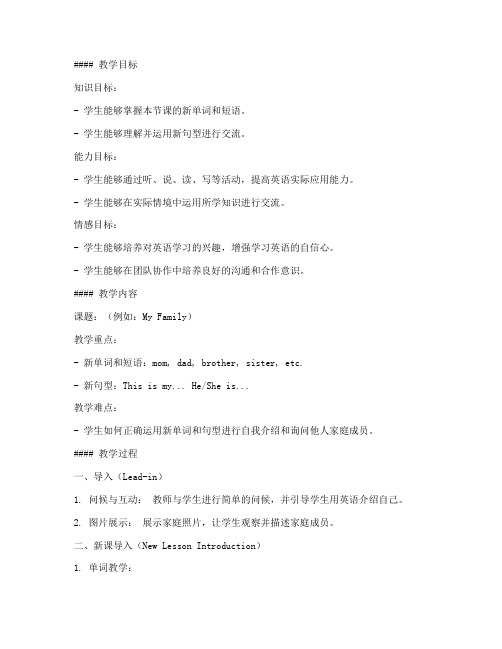
#### 教学目标知识目标:- 学生能够掌握本节课的新单词和短语。
- 学生能够理解并运用新句型进行交流。
能力目标:- 学生能够通过听、说、读、写等活动,提高英语实际应用能力。
- 学生能够在实际情境中运用所学知识进行交流。
情感目标:- 学生能够培养对英语学习的兴趣,增强学习英语的自信心。
- 学生能够在团队协作中培养良好的沟通和合作意识。
#### 教学内容课题:(例如:My Family)教学重点:- 新单词和短语:mom, dad, brother, sister, etc.- 新句型:This is my... He/She is...教学难点:- 学生如何正确运用新单词和句型进行自我介绍和询问他人家庭成员。
#### 教学过程一、导入(Lead-in)1. 问候与互动:教师与学生进行简单的问候,并引导学生用英语介绍自己。
2. 图片展示:展示家庭照片,让学生观察并描述家庭成员。
二、新课导入(New Lesson Introduction)1. 单词教学:- 教师板书新单词,如:mom, dad, brother, sister,并解释其含义。
- 学生跟读,教师纠正发音。
2. 句型教学:- 教师板书新句型:This is my... He/She is...- 学生跟读,教师示范如何运用句型进行自我介绍和询问他人家庭成员。
三、课堂活动(Class Activities)1. 小组讨论:- 将学生分成小组,让学生用新单词和句型描述自己的家庭成员。
2. 角色扮演:- 教师组织学生进行角色扮演,模拟家庭场景,运用所学知识进行交流。
3. 游戏环节:- 设计与家庭相关的游戏,如“猜猜他是谁”,让学生在游戏中巩固所学知识。
四、课堂小结(Summary)1. 回顾本节课所学内容:- 教师引导学生回顾新单词、短语和句型。
2. 布置作业:- 让学生用所学知识描述自己的家庭,并尝试用英语进行自我介绍。
#### 教学反思1. 教学效果:通过观察学生的课堂表现,评估学生对新知识的掌握程度。
- 1、下载文档前请自行甄别文档内容的完整性,平台不提供额外的编辑、内容补充、找答案等附加服务。
- 2、"仅部分预览"的文档,不可在线预览部分如存在完整性等问题,可反馈申请退款(可完整预览的文档不适用该条件!)。
- 3、如文档侵犯您的权益,请联系客服反馈,我们会尽快为您处理(人工客服工作时间:9:00-18:30)。
课题:
Unit 1 Welcome back to school! 第四课时
教学重点:
听懂、会说:“Where are you from? I’m from….This is my friend…”
教学难点:在情境中运用语言及单词from的发音。
教具准备:
1.学生自己的头饰
2.游戏用的人物名片
3.配套的教学课件
4.游戏用的录音音乐
5.Mr.Black的头饰和钟表
教学过程:
热身/复习(Warm-up/Revision)
1.孩子出示自己的头饰,做自我介绍:“I’m lily. I’m from Canada。
”
(引导其他孩子用:“Good morning. lily!”回答)
2.学生以小组为单位扩展表演A部分Let’s talk的对话。
(不同孩子扮演对话中的不同人物,孩子也可以根据自己的情况做扩展表演。
)
呈现新课(Presentation)
1.game
(教师制作一些人物名片,并在卡片背面画上国家的国旗)听音乐,传卡片。
拿到卡片的孩子到前面扮演卡片上的人物。
做自我介绍:“I’m Amy.”教师提问:“Where are you from?”孩子回答“I’m from America.”
孩子们试着提问:“Where are you from?”得到小卡片的同学根据情况回答。
2.学生小组间的问答:“Where are you from?”“I’m from…”(根据孩子自己制作的头饰回答)
3.请几个小组开火车问答:“Where are you from?”
4.教师出示钟表(把时间调到下午):“Good afternoon!”教师带上Mr. Black的头饰(走到一位学生面前)说:“Good afternoon! My name’s Mr. Black. I ’m from China.”孩子根据自己的情况回答:“Good afternoon, Mr. Black. I’m Xiao Dong . I’m from China.”
教师提问一组孩子。
然后请学生到前面来扮演Mr. Black.
5.教师带着Mr. Black 的头饰走到台前,说:“I have a friend in our class. Do you know who’s she?”教师指着扮演Amy的同学说:“This is my friend Amy.”(引导全班孩子问好)
Ss: Nice to meet you.
A: Nice to meet you, too!
Ss: Where are you from?
A: I’m from America.
Ss: Welcome!
6.教师播放Let’s talk部分的课件, 学生观看对话。
跟读、模仿,分角色给课件配音。
7.小组分角色练习对话。
8.小组表演对话。
趣味操练(Practice)
1.Listen and order the cards: 将课文图片打乱顺序,让孩子听一听, 摆一摆。
2.表演Let’s talk部分的对话。
3.小组中互换头饰(国家、名字),进行对话练习。
(Where are you from? I’m from… )扩展性活动(Add-activities)
介绍好朋友,请孩子用所学的句型把自己的好朋友介绍给大家。
来源:中师教育 。
